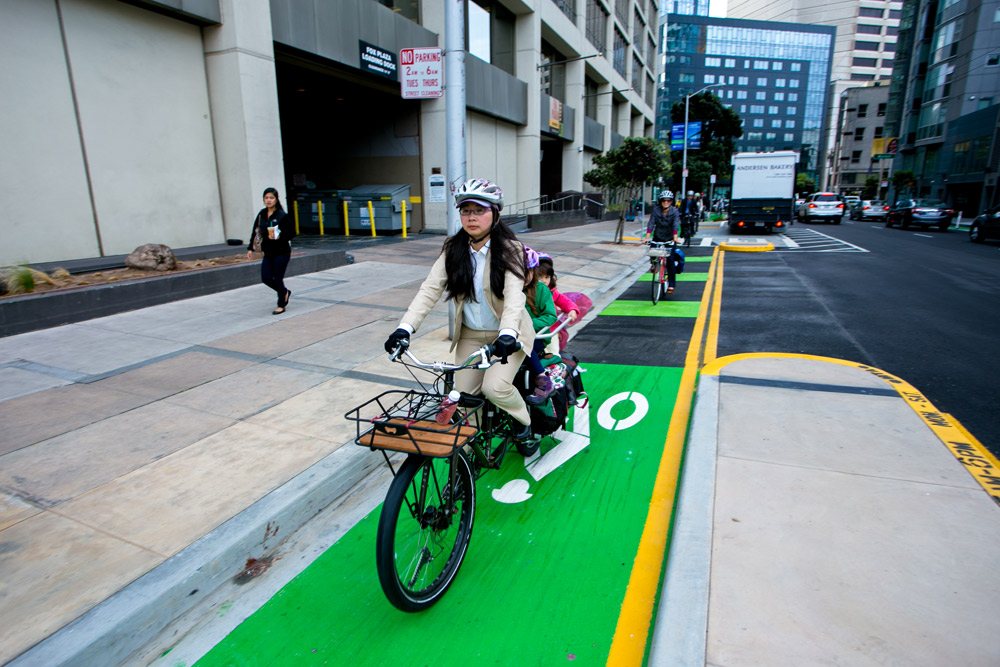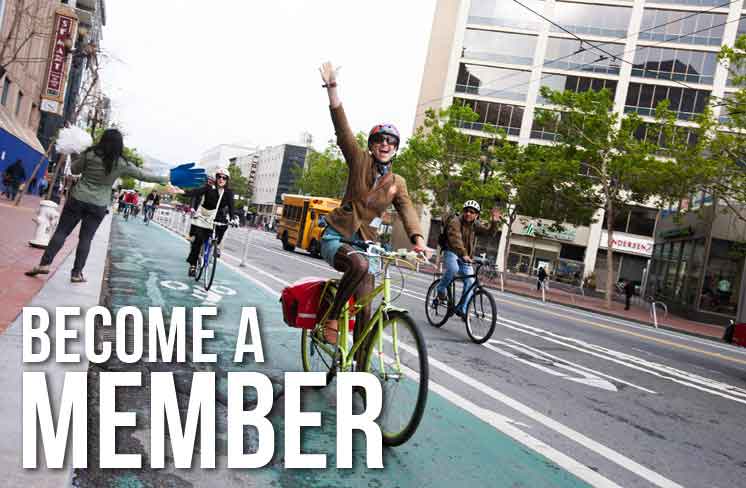For anyone who rides a bike regularly, we know anecdotally that protected bike lanes make a huge difference. We feel safer. We feel welcome on the streets, navigating them calmly to get from place to place.
But just how safe are we, and how much does the design of our streets change behaviors?
Turns out, it’s a lot.
A new academic study of protected bicycle lanes (click for PDF) was released earlier this month – the first ever for the United States. This study, prepared for the National Institute for Transportation and Communities, examined eight different locations throughout the country, collecting extensive data and surveys. One of the eight locations was right here in San Francisco, on Fell and Oak Streets. Overall, the study showed that protected bicycle lanes are overwhelmingly safe by nearly eliminating all conflict between modes. There was also a strong growth in ridership, where protected bikeways inspired more new riders to get on their bikes with as much as a 171% increase.
Out of the eight locations, Fell and Oak Streets are unique in that they are already popular bicycle routes. They constitute the heart of the “Bay to the Beach Bikeway,” one of three major Connecting the City routes. While bike counts continued to outpace citywide growth in ridership after the installation (50% increase on Fell Street versus 10% citywide), the more telling information came from observations on how we share our streets when we have protected bicycle lanes.
1. Intersections make sense.
Crossing large streets can often be confusing. There are lights, turning vehicles, lane changes and more. The study showed that the design of Fell and Oak Streets make it overwhelmingly clear where vehicles go and where bicycles go, whether you’re making a turn or going straight. Over 90% of local residents polled in the NITC study stated that they understood the “mixing zones” at four different intersections. That leads us to the study’s next conclusion:
2. Good design means good behavior.
At Oak Street and Divisadero Street, 98% of people on bicycles waited at red lights to legally cross the intersection. This intersection features a bike box, a “through bicycle lane” and green paint where the lanes begin to guide you through.
The SF Municipal Transportation Agency’s preliminary findings from October 2013 support these findings but also showed there was a reduction of people riding bicycles on sidewalks as well.
3. Protected bike lanes are very, very safe.
Qualitative surveys continue to show that people feel much more safe when bike lanes have a buffer from vehicle traffic. Both SFMTA and NITC’s studies show that 98% of people biking feel safer with the protected bicycle lanes. When it comes to driving, 62% of residents felt that the safety of driving had increased or was not affected.
The NITC study went further to observe the interactions, observing over a thousand bicycles on Oak Street passing through Broderick Street. Data was collected over three 12-hour periods on a Wednesday, Thursday and Saturday last fall. There were zero instances of conflict recorded.
4. This needs to be the model for bike lanes in San Francisco.
We recently celebrated the new bike lanes on Polk Street, showcasing good, high-quality design can also be beautiful. Protected bicycle lanes are sparse throughout the city, but we continue to see more and more facilities being built, like on San Jose Avenue. Across the board and regardless of primary commute mode, 75% of survey respondents said they want more protected bicycle lanes. Even more telling, though, was that 92% of people biking on Fell and Oak Streets felt that the protected lanes there were safer than biking anywhere else in San Francisco.
As our streets continue to evolve, we see just these three blocks along Fell and Oak Streets becoming a model for the rest of San Francisco. Still, the work is not yet done even on Fell and Oak Streets. While there is a painted buffer, the final design will include concrete planters to create a permanent, physical barrier. Aside from being much safer, this would also eliminate double-parking in the bicycle lane. We continue to move this project forward as the City fulfills its commitment to the final design, and we hope to see more of these beautiful, high-quality bicycle lanes continuing to connect the city as more and more people of all ages choose the bicycle as a way of getting around.
Want to connect the city with more crosstown bikeways? BECOME A MEMBER OF THE SF BICYCLE COALITION TODAY and support our work to win more protected bikeways.


